Salby M.L. Fundamentals of Atmospheric Physics
Подождите немного. Документ загружается.

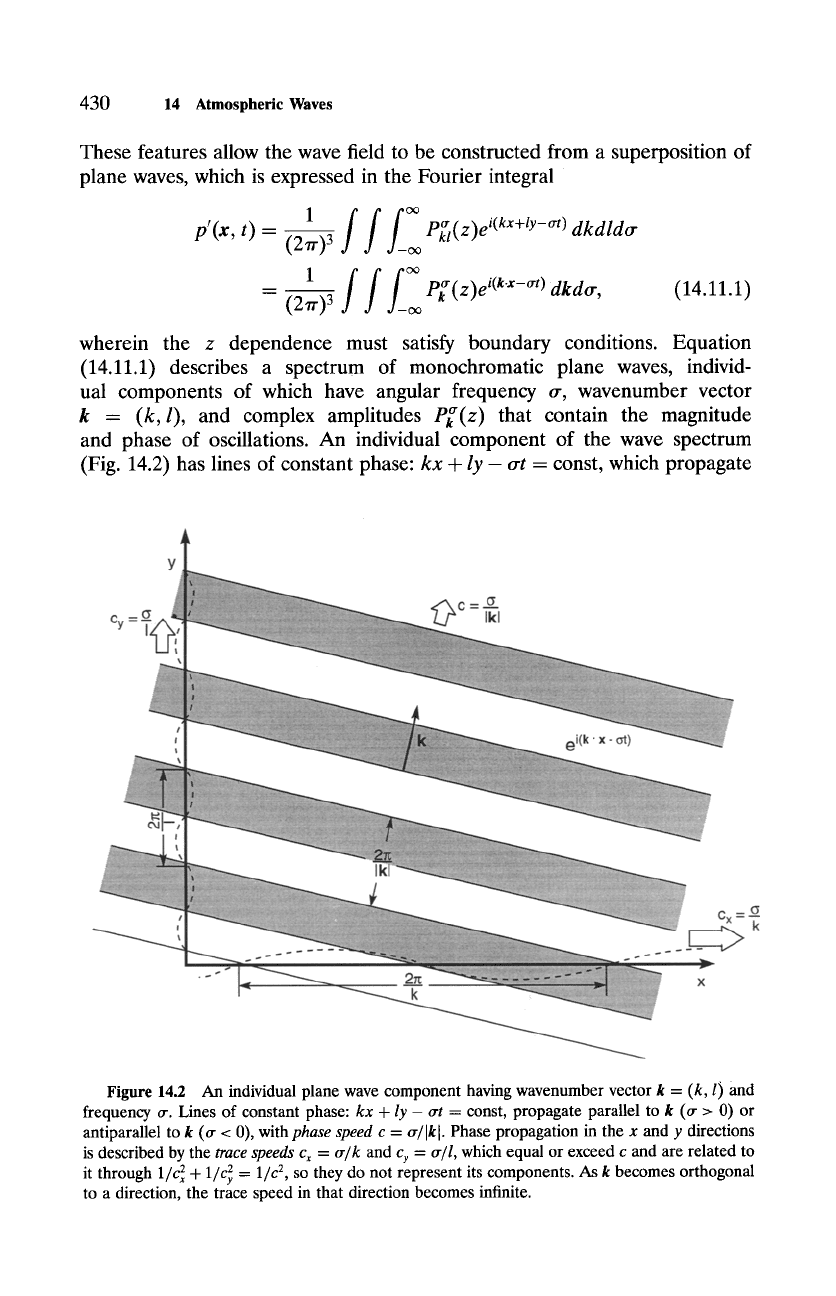
430 14 Atmospheric Waves
These features allow the wave field to be constructed from a superposition of
plane waves, which is expressed in the Fourier integral
1
p'(x, t) - (21r)3 f f f P~l(z)ei(kx+ly-~t' dkdld~r
l fff
: (2,n.) 3 ~
Pff(z)e i(k'x-crt) dkdcr,
(14.11.1)
wherein the z dependence must satisfy boundary conditions. Equation
(14.11.1) describes a spectrum of monochromatic plane waves, individ-
ual components of which have angular frequency or, wavenumber vector
k = (k,l),
and complex amplitudes
P~(z)
that contain the magnitude
and phase of oscillations. An individual component of the wave spectrum
(Fig. 14.2) has lines of constant phase:
kx + ly-
at = const, which propagate
Y
Cy T, Ikl
i
! ! I
.,,.... ...... . ....."
c=~
2~; " ~ .... ~. x
k -"
Figure 14.2 An individual plane wave component having wavenumber vector k = (k, l) and
frequency tr. Lines of constant phase:
kx + ly-
trt - const, propagate parallel to k (tr > 0) or
antiparallel to k (tr < 0), with
phase speed c = tr/[k[.
Phase propagation in the x and y directions
is described by the
trace speeds Cx = tr/k
and
Cy = o/l,
which equal or exceed c and are related to
it through
1/c 2 + 1/c 2
=
1/C 2,
SO they do not represent its components. As k becomes orthogonal
to a direction, the trace speed in that direction becomes infinite.
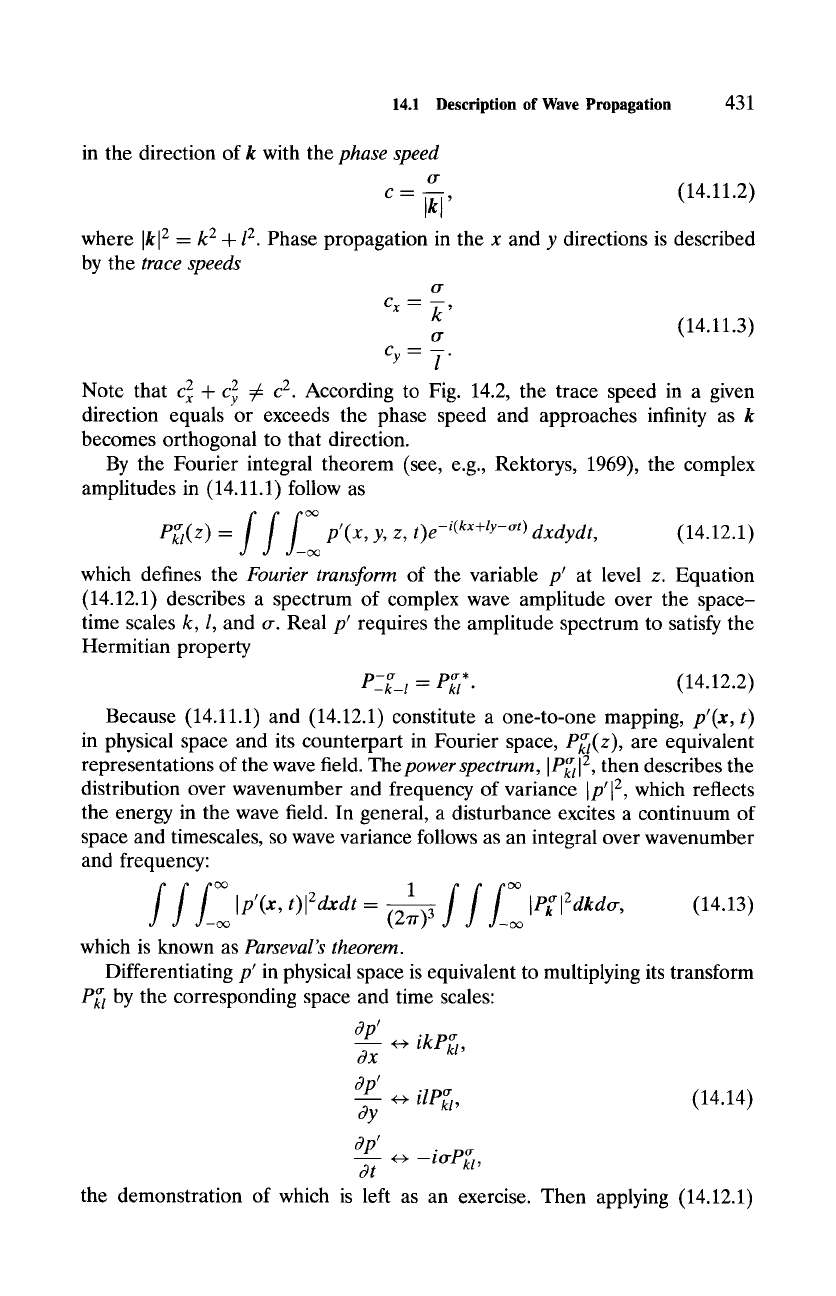
14.1 Description of Wave Propagation
431
in the direction of k with the
phase speed
o"
c = ik I , (14.11.2)
where
Ikl 2
= k 2 + l 2. Phase propagation in the x and y directions is described
by the
trace speeds
o-
Cx= k'
or (14.11.3)
Cy = -{ .
2 2 r
Note that
c x + Cy ~
According to Fig. 14.2, the trace speed in a given
direction equals or exceeds the phase speed and approaches infinity as k
becomes orthogonal to that direction.
By the Fourier integral theorem (see, e.g., Rektorys, 1969), the complex
amplitudes in (14.11.1) follow as
fff
Pk~(z) -- p'(x, y,
z, t)e -i(kx+ly-~rt)
dxdydt,
(14.12.1)
O0
which defines the
Fourier transform
of the variable p' at level z. Equation
(14.12.1) describes a spectrum of complex wave amplitude over the space-
time scales k, l, and o-. Real p' requires the amplitude spectrum to satisfy the
Hermitian property
-~ - P~* (14.12.2)
P-~-t ~t 9
Because (14.11.1) and (14.12.1) constitute a one-to-one mapping,
p'(x, t)
in physical space and its counterpart in Fourier space,
P~(z),
are equivalent
representations of the wave field. The
power spectrum, IP~I
12, then describes the
distribution over wavenumber and frequency of variance [p,[2, which reflects
the energy in the wave field. In general, a disturbance excites a continuum of
space and timescales, so wave variance follows as an integral over wavenumber
and frequency:
1 ~ 12
f f
Ip'(x,
t)12dxdt-(2,rr) 3
f f f=
IP~ dkdcr,
(14.13)
which is known as
Parseval's theorem.
Differentiating p' in physical space is equivalent to multiplying its transform
P~t by the corresponding space and time scales:
ap'
ikP~,
8x
•p!
ilP~z,
(14.14)
ay
ap,
+-~ -i~rP~t ,
3t
the demonstration of which is left as an exercise. Then applying (14.12.1)
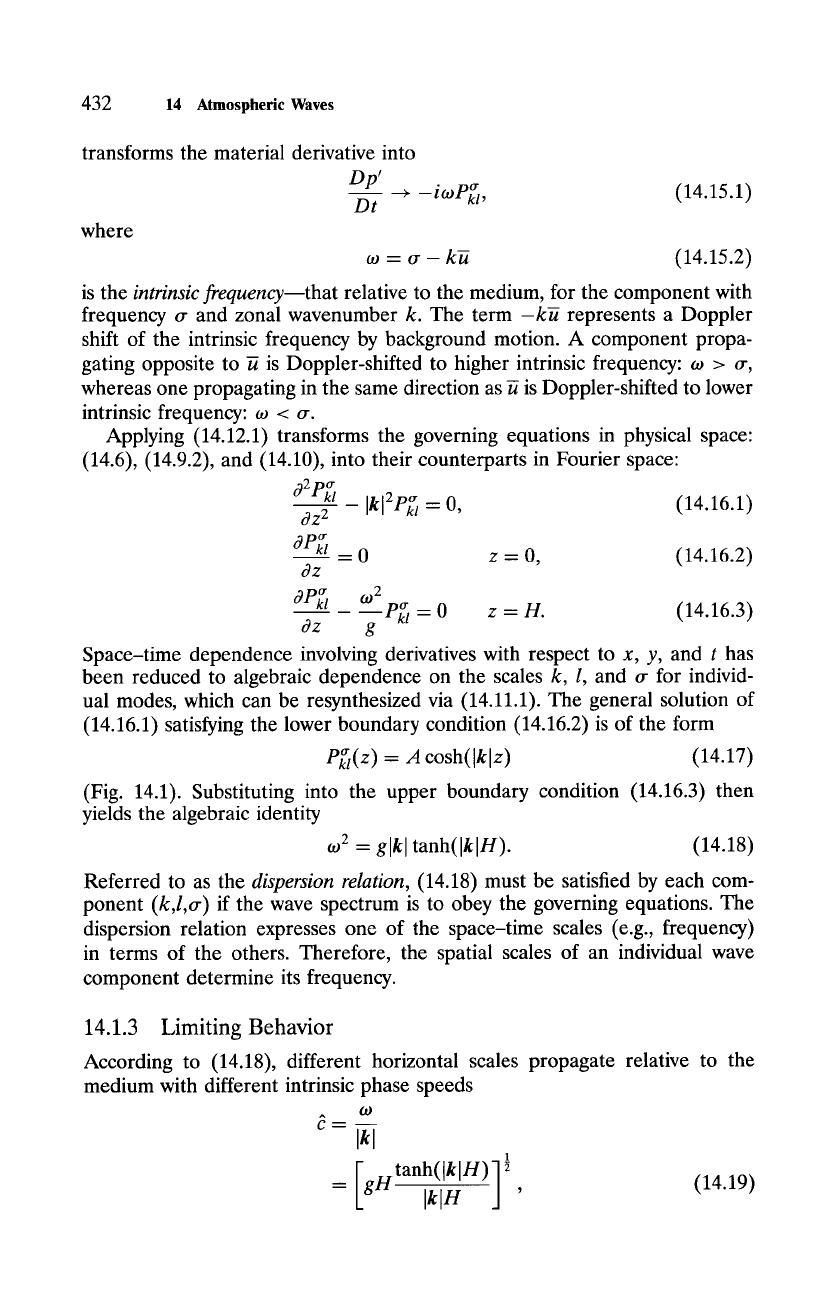
432 14
Atmospheric Waves
transforms the material derivative into
Dp'
Dt
--+ --iwPk~l,
(14.15.1)
where
to - o- kK (14.15.2)
is the
intrinsic frequencymthat
relative to the medium, for the component with
frequency ~r and zonal wavenumber k. The term -kK represents a Doppler
shift of the intrinsic frequency by background motion. A component propa-
gating opposite to ~ is Doppler-shifted to higher intrinsic frequency: w > ~r,
whereas one propagating in the same direction as K is Doppler-shifted to lower
intrinsic frequency: o~ < or.
Applying (14.12.1) transforms the governing equations in physical space:
(14.6), (14.9.2), and (14.10), into their counterparts in Fourier space:
32Pfft
Ikl2e~
= 0, (14.16.1)
~Z 2
aPk
= 0 z = O, (14.16.2)
3z
OPk~l to 2
Pk5 -- 0 Z = H.
(14.16.3)
3z g
Space-time dependence involving derivatives with respect to x, y, and t has
been reduced to algebraic dependence on the scales k, l, and o- for individ-
ual modes, which can be resynthesized via (14.11.1). The general solution of
(14.16.1) satisfying the lower boundary condition (14.16.2) is of the form
Pfft(z) = Z
cosh(Iklz) (14.17)
(Fig. 14.1). Substituting into the upper boundary condition (14.16.3) then
yields the algebraic identity
o~ 2 - glkl
tanh(Ikln). (14.18)
Referred to as the
dispersion relation,
(14.18) must be satisfied by each com-
ponent
(k,l,~r)
if the wave spectrum is to obey the goveming equations. The
dispersion relation expresses one of the space-time scales (e.g., frequency)
in terms of the others. Therefore, the spatial scales of an individual wave
component determine its frequency.
14.1.3 Limiting Behavior
According to (14.18), different horizontal scales propagate relative to the
medium with different intrinsic phase speeds
s
Ikl
1
_
[gHtanh(Ikl
~ ] '
(14.19)
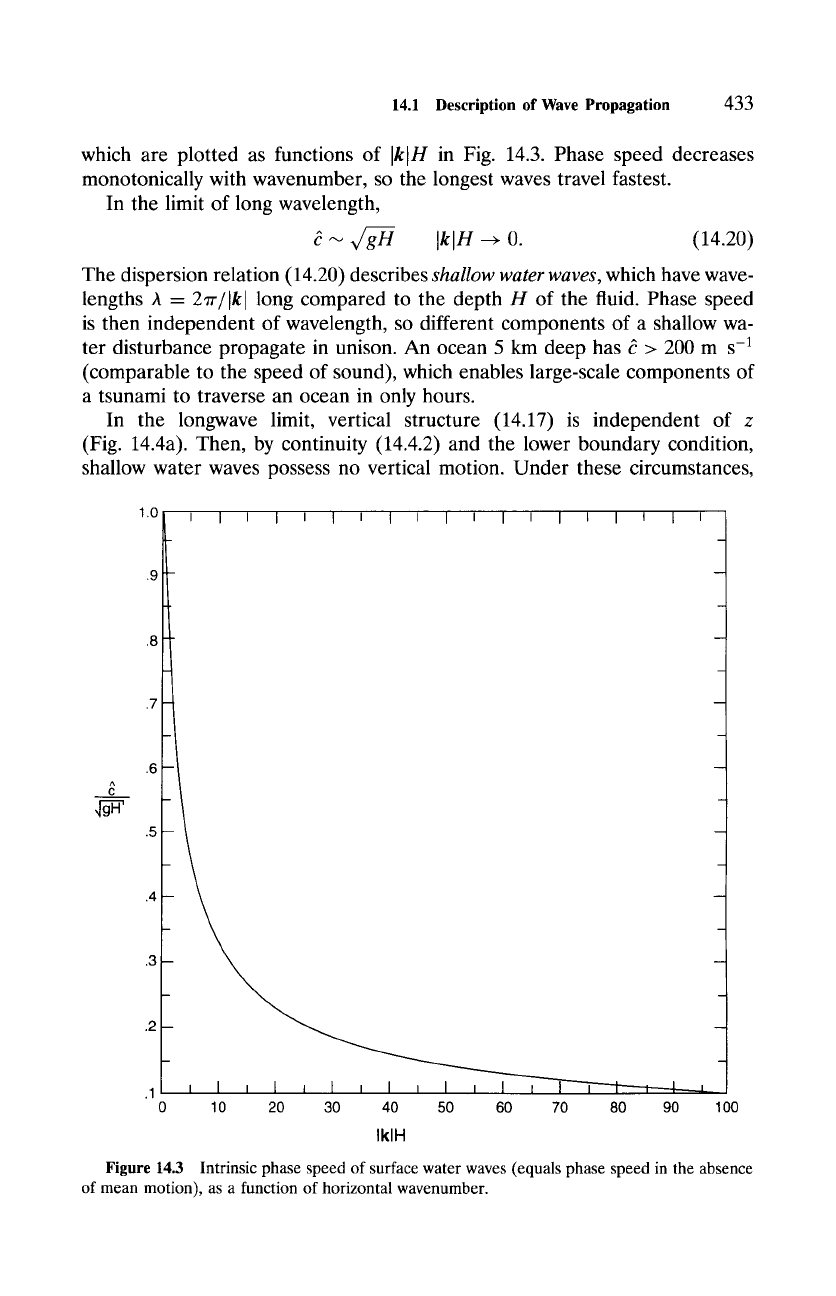
14.1
Description of Wave Propagation
433
which are plotted as functions of IklH in Fig. 14.3. Phase speed decreases
monotonically with wavenumber, so the longest waves travel fastest.
In the limit of long wavelength,
~ ~ Ikln --+ O. (14.20)
The dispersion relation (14.20) describes shallow water waves, which have wave-
lengths A = 2~r/Ikl long compared to the depth H of the fluid. Phase speed
is then independent of wavelength, so different components of a shallow wa-
ter disturbance propagate in unison. An ocean 5 km deep has ~ > 200 m s -1
(comparable to the speed of sound), which enables large-scale components of
a tsunami to traverse an ocean in only hours.
In the longwave limit, vertical structure (14.17) is independent of z
(Fig. 14.4a). Then, by continuity (14.4.2) and the lower boundary condition,
shallow water waves possess no vertical motion. Under these circumstances,
1.0
I I I I I I I I I I I I I I I I I I
.1
0 10 20 30 40 50 60 70 80 90 100
IkIH
Figure 14.3 Intrinsic phase speed of surface water waves (equals phase speed in the absence
of mean motion), as a function of horizontal wavenumber.
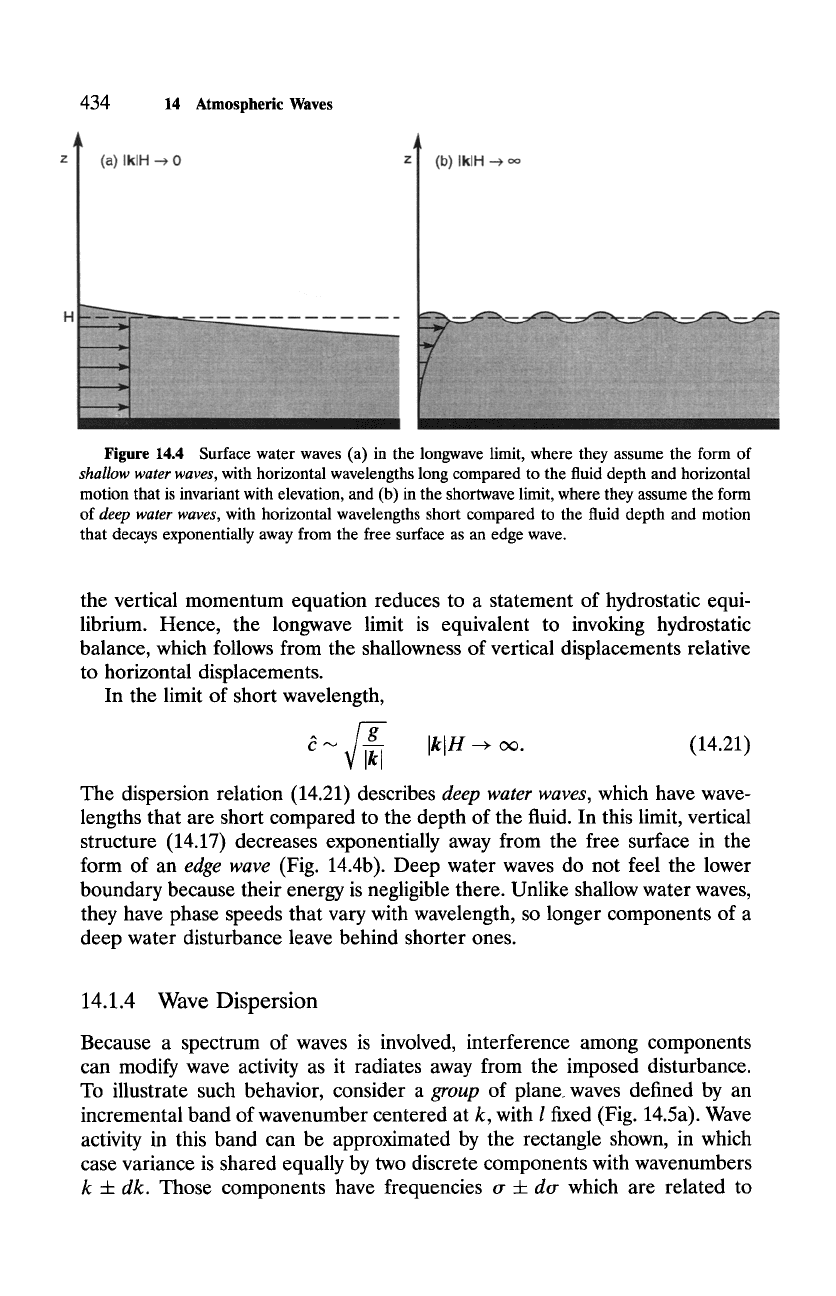
434
14
Atmospheric Waves
(a) IklH ---> 0
(b) IklH ---> oo
Figure 14.4 Surface water waves (a) in the longwave limit, where they assume the form of
shallow water waves, with horizontal wavelengths long compared to the fluid depth and horizontal
motion that is invariant with elevation, and (b) in the shortwave limit, where they assume the form
of
deep water waves, with horizontal wavelengths short compared to the fluid depth and motion
that decays exponentially away from the free surface as an edge wave.
the vertical momentum equation reduces to a statement of hydrostatic equi-
librium. Hence, the longwave limit is equivalent to invoking hydrostatic
balance, which follows from the shallowness of vertical displacements relative
to horizontal displacements.
In the limit of short wavelength,
~ ~~kl Ik[H--> oo.
(14.21)
The dispersion relation (14.21) describes
deep water waves,
which have wave-
lengths that are short compared to the depth of the fluid. In this limit, vertical
structure (14.17) decreases exponentially away from the free surface in the
form of an
edge wave
(Fig. 14.4b). Deep water waves do not feel the lower
boundary because their energy is negligible there. Unlike shallow water waves,
they have phase speeds that vary with wavelength, so longer components of a
deep water disturbance leave behind shorter ones.
14.1.4 Wave Dispersion
Because a spectrum of waves is involved, interference among components
can modify wave activity as it radiates away from the imposed disturbance.
To illustrate such behavior, consider a
group
of plane, waves defined by an
incremental band of wavenumber centered at k, with I fixed (Fig. 14.5a). Wave
activity in this band can be approximated by the rectangle shown, in which
case variance is shared equally by two discrete components with wavenumbers
k + dk.
Those components have frequencies tr + dtr which are related to
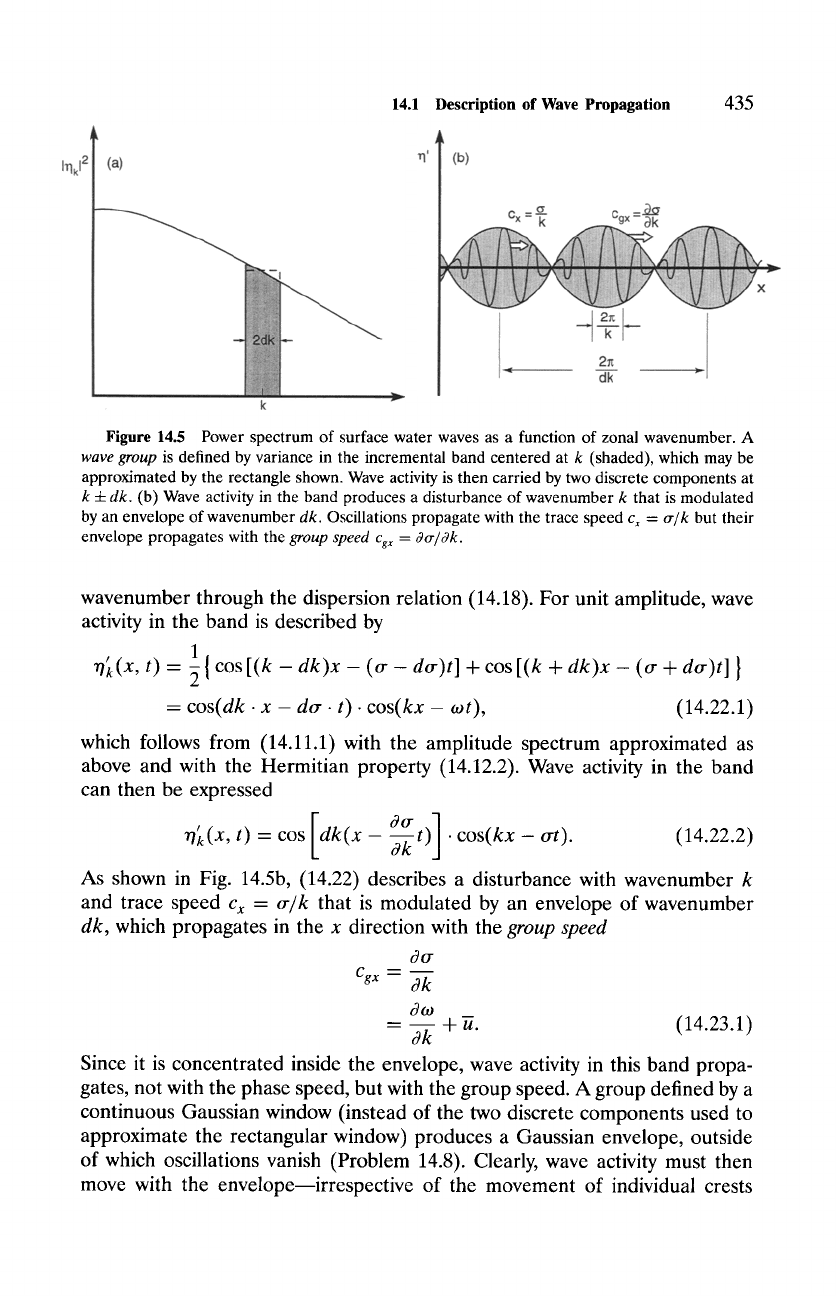
I'rlk 12
14.1 Description of Wave Propagation
435
(a)
(b)
c -_0_~
. __ gx- ~k
V -
q h-
2~
dk
Figure 14.5 Power spectrum of surface water waves as a function of zonal wavenumber. A
wave group
is defined by variance in the incremental band centered at k (shaded), which may be
approximated by the rectangle shown. Wave activity is then carried by two discrete components at
k -4-dk.
(b) Wave activity in the band produces a disturbance of wavenumber k that is modulated
by an envelope of wavenumber
dk.
Oscillations propagate with the trace speed
c x = tr/k
but their
envelope propagates with the
group speed Cgx = ~tr/,3k.
wavenumber through the dispersion relation (14.18). For unit amplitude, wave
activity in the band is described by
, 1
wk(x, t) - ~{ cos [(~ -
dk)x - (,~ - d~)t] +
cos [(~ +
d~:)x - (~ + d~)t] }
- cos(dk 9 x - do-. t). cos(kx - tot), (14.22.1)
which follows from (14.11.1) with the amplitude spectrum approximated as
above and with the Hermitian property (14.12.2). Wave activity in the band
can then be expressed
r/~(x, t) -- cos
dk(x - -~t) 9
cos(kx - o-t). (14.22.2)
As shown in Fig. 14.5b, (14.22) describes a disturbance with wavenumber k
and trace speed
Cx = o-/k
that is modulated by an envelope of wavenumber
dk,
which propagates in the x direction with the
group speed
3o-
Cgx = 3k
3to
m
= ~k + u. (14.23.1)
Since it is concentrated inside the envelope, wave activity in this band propa-
gates, not with the phase speed, but with the group speed. A group defined by a
continuous Gaussian window (instead of the two discrete components used to
approximate the rectangular window) produces a Gaussian envelope, outside
of which oscillations vanish (Problem 14.8). Clearly, wave activity must then
move with the envelope~irrespective of the movement of individual crests
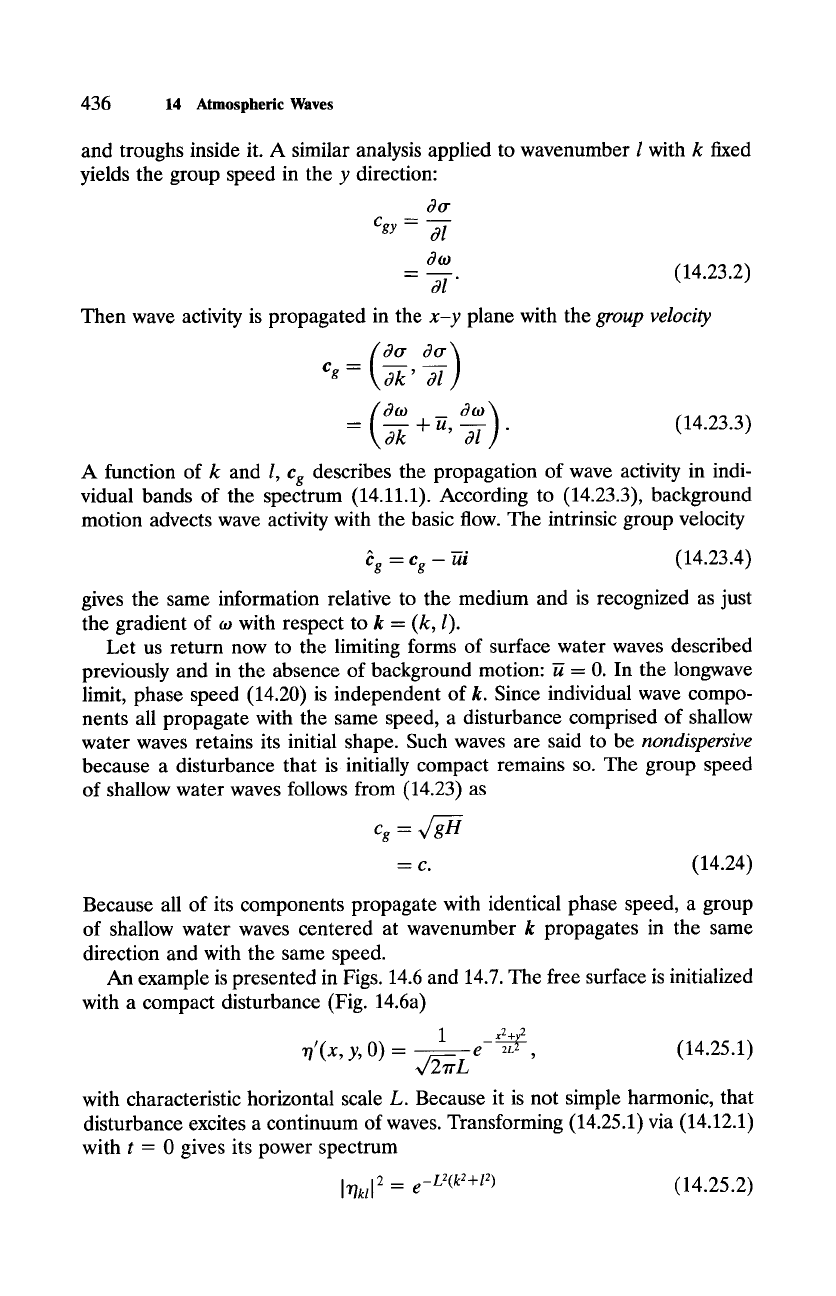
436
14
Atmospheric Waves
and troughs inside it. A similar analysis applied to wavenumber I with k fixed
yields the group speed in the y direction:
30"
Cgy = 31
3to
= ---/. (14.23.2)
Then wave activity is propagated in the
x-y
plane with the
group velocity
30" 30")
Ok'31
oo)
= .
r
(14.23.3)
A function of k and l,
Cg
describes the propagation of wave activity in indi-
vidual bands of the spectrum (14.11.1). According to (14.23.3), background
motion advects wave activity with the basic flow. The intrinsic group velocity
~:g - Cg - -~i
(14.23.4)
gives the same information relative to the medium and is recognized as just
the gradient of to with respect to k = (k, l).
Let us return now to the limiting forms of surface water waves described
previously and in the absence of background motion: K = 0. In the longwave
limit, phase speed (14.20) is independent of k. Since individual wave compo-
nents all propagate with the same speed, a disturbance comprised of shallow
water waves retains its initial shape. Such waves are said to be
nondispersive
because a disturbance that is initially compact remains so. The group speed
of shallow water waves follows from (14.23) as
Cg = x/gH
= c. (14.24)
Because all of its components propagate with identical phase speed, a group
of shallow water waves centered at wavenumber k propagates in the same
direction and with the same speed.
An example is presented in Figs. 14.6 and 14.7. The free surface is initialized
with a compact disturbance (Fig. 14.6a)
x 2 +y2
r/'(x, y, 0) = ~_~------~e 2L-z , (14.25.1)
with characteristic horizontal scale L. Because it is not simple harmonic, that
disturbance excites a continuum of waves. Transforming (14.25.1) via (14.12.1)
with t = 0 gives its power spectrum
[ r/k/I 2=
e -L2(k2+12)
(14.25.2)
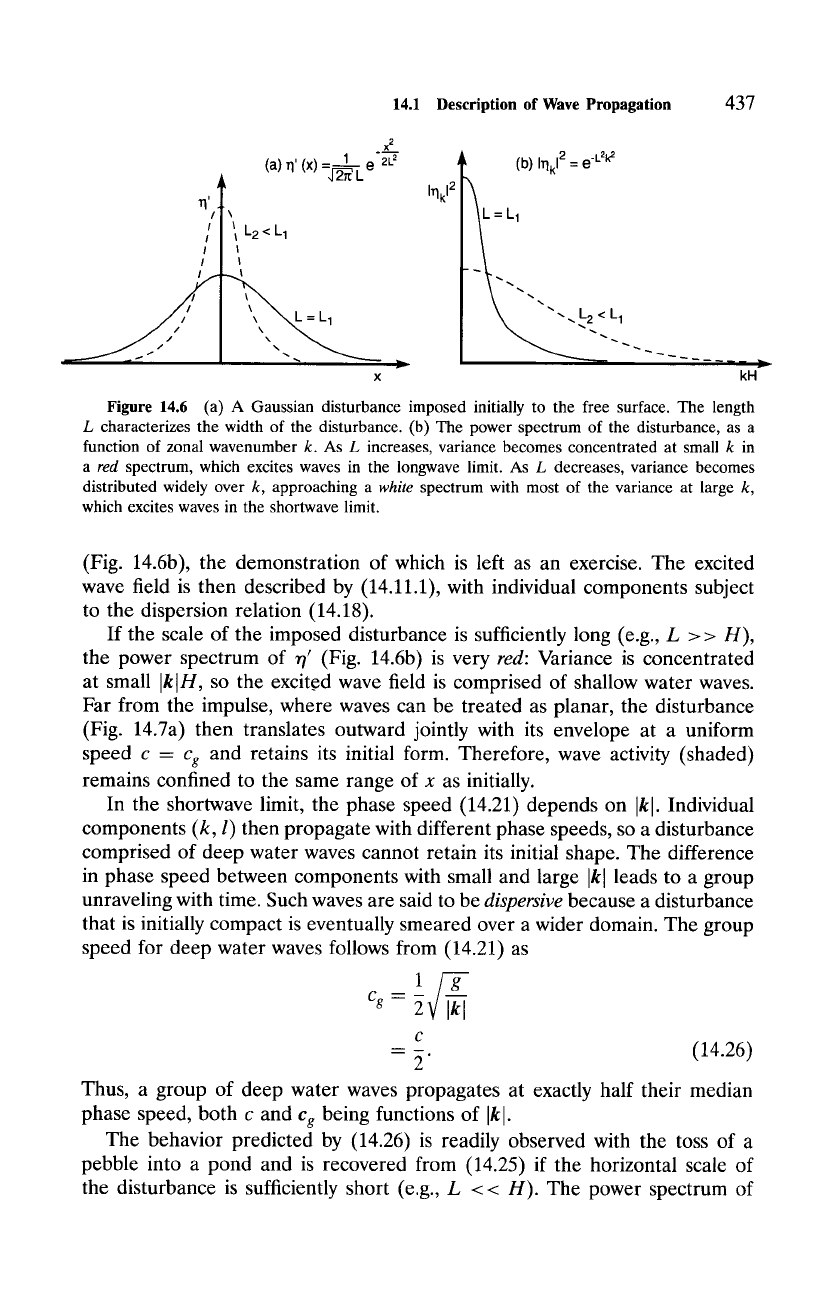
14.1
Description of Wave Propagation
437
x 2
_
1 2L 2
(a) q' (x)-~---L e
~','I \', L2<L I
/1i
/l '~~L
=
L 1
Irlk 12
(b) Irlk 12 = e "L2k2
...
L1 ~
kN
Figure 14.6
(a) A Gaussian disturbance imposed initially to the free surface. The length
L characterizes the width of the disturbance. (b) The power spectrum of the disturbance, as a
function of zonal wavenumber k. As L increases, variance becomes concentrated at small k in
a red
spectrum, which excites waves in the longwave limit. As L decreases, variance becomes
distributed widely over k, approaching a
white
spectrum with most of the variance at large k,
which excites waves in the shortwave limit.
(Fig. 14.6b), the demonstration of which is left as an exercise. The excited
wave field is then described by (14.11.1), with individual components subject
to the dispersion relation (14.18).
If the scale of the imposed disturbance is sufficiently long (e.g., L > > H),
the power spectrum of r/' (Fig. 14.6b) is very
red:
Variance is concentrated
at small
IklH,
so the excit.ed wave field is comprised of shallow water waves.
Far from the impulse, where waves can be treated as planar, the disturbance
(Fig. 14.7a) then translates outward jointly with its envelope at a uniform
speed c = c~ and retains its initial form. Therefore, wave activity (shaded)
remains confined to the same range of x as initially.
In the shortwave limit, the phase speed (14.21) depends on
Ikl.
Individual
components (k, l) then propagate with different phase speeds, so a disturbance
comprised of deep water waves cannot retain its initial shape. The difference
in phase speed between components with small and large
Ikl
leads to a group
unraveling with time. Such waves are said to be
dispersive
because a disturbance
that is initially compact is eventually smeared over a wider domain. The group
speed for deep water waves follows from (14.21) as
cg-~ Ikl
c
-- ~. (14.26)
Thus, a group of deep water waves propagates at exactly half their median
phase speed, both c and
cg
being functions of
Ikl.
The behavior predicted by (14.26) is readily observed with the toss of a
pebble into a pond and is recovered from (14.25) if the horizontal scale of
the disturbance is sufficiently short (e.g., L < < H). The power spectrum of
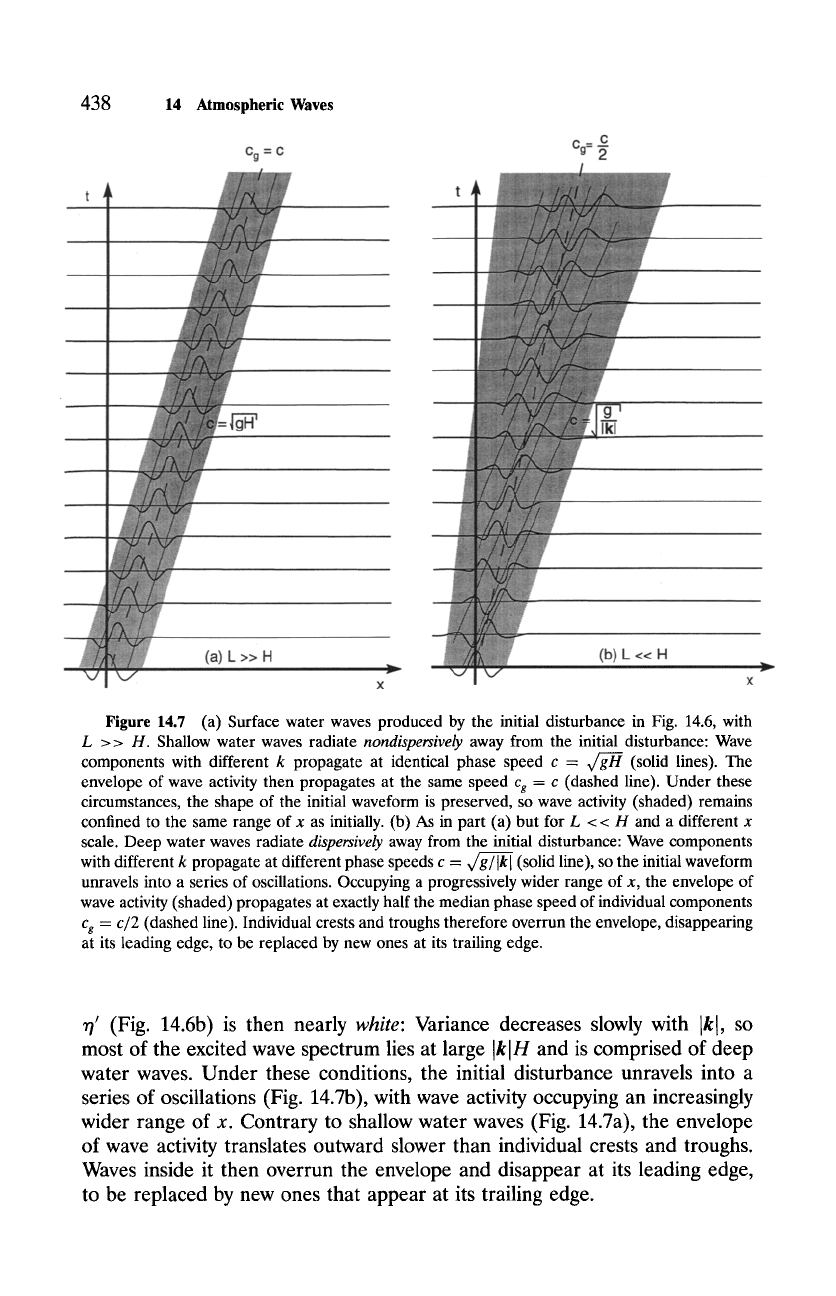
438
14 Atmospheric Waves
Cg=C
C
Cg= ~.
(a) L >> H
m
Ikl
L H
(b) <<
Figure 14.7 (a) Surface water waves produced by the initial disturbance in Fig. 14.6, with
L > > H. Shallow water waves radiate
nondispersively
away from the initial disturbance: Wave
components with different k propagate at identical phase speed c = ~ (solid lines). The
envelope of wave activity then propagates at the same speed c 8 = c (dashed line). Under these
circumstances, the shape of the initial waveform is preserved, so wave activity (shaded) remains
confined to the same range of x as initially. (b) As in part (a) but for L < < H and a different x
scale. Deep water waves radiate
dispersively
away from the initial disturbance: Wave components
with different k propagate at different phase speeds c = ~ (solid line), so the initial waveform
unravels into a series of oscillations. Occupying a progressively wider range of x, the envelope of
wave activity (shaded) propagates at exactly half the median phase speed of individual components
cg = c/2
(dashed line). Individual crests and troughs therefore overrun the envelope, disappearing
at its leading edge, to be replaced by new ones at its trailing edge.
r/' (Fig. 14.6b) is then nearly
white:
Variance decreases slowly with [kl, so
most of the excited wave spectrum lies at large
IklH
and is comprised of deep
water waves. Under these conditions, the initial disturbance unravels into a
series of oscillations (Fig. 14.7b), with wave activity occupying an increasingly
wider range of x. Contrary to shallow water waves (Fig. 14.7a), the envelope
of wave activity translates outward slower than individual crests and troughs.
Waves inside it then overrun the envelope and disappear at its leading edge,
to be replaced by new ones that appear at its trailing edge.
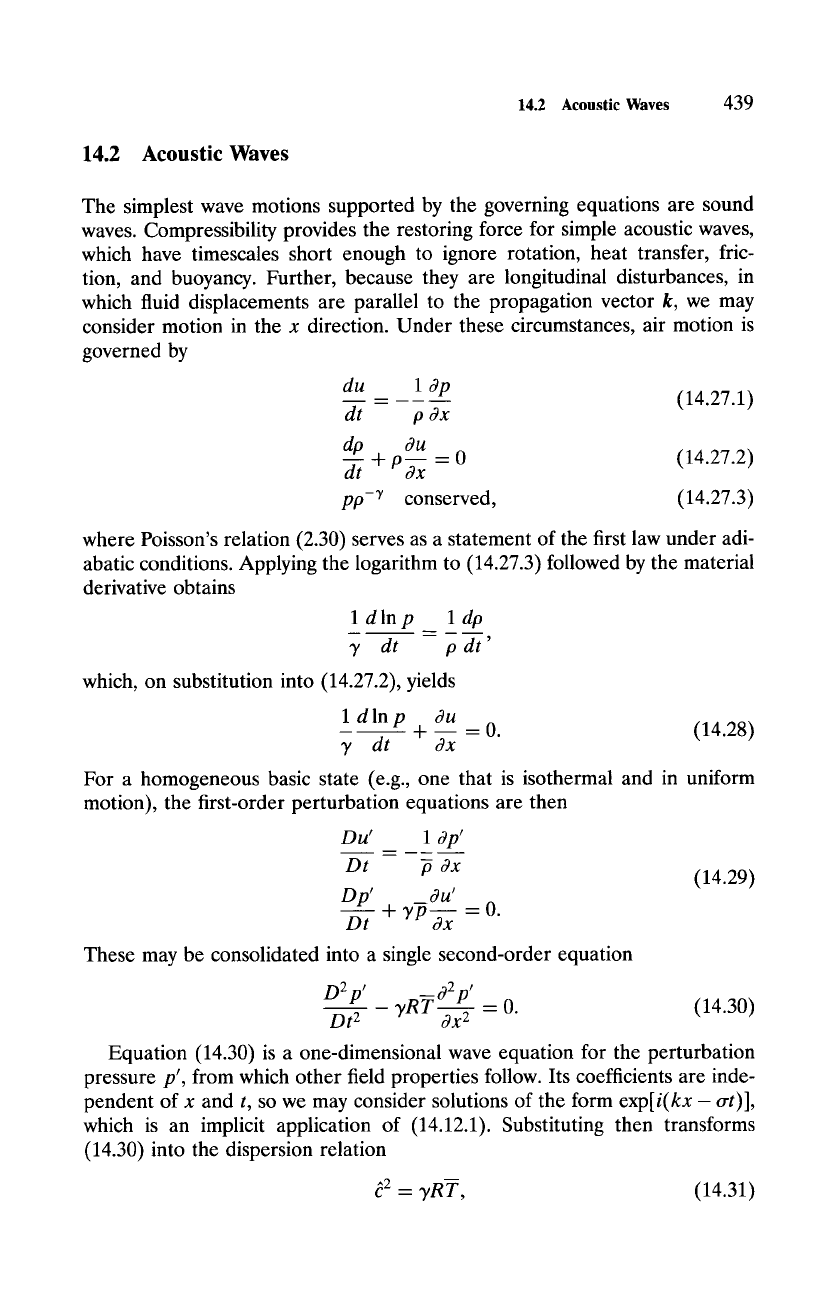
14.2 Acoustic Waves 439
14.2 Acoustic Waves
The simplest wave motions supported by the governing equations are sound
waves. Compressibility provides the restoring force for simple acoustic waves,
which have timescales short enough to ignore rotation, heat transfer, fric-
tion, and buoyancy. Further, because they are longitudinal disturbances, in
which fluid displacements are parallel to the propagation vector k, we may
consider motion in the x direction. Under these circumstances, air motion is
governed by
du 1 ~p
= (14.27.1)
dt p dx
m_
du
dp l- p-- - 0 (14.27.2)
dt dx
pp-~ conserved, (14.27.3)
where Poisson's relation (2.30) serves as a statement of the first law under adi-
abatic conditions. Applying the logarithm to (14.27.3) followed by the material
derivative obtains
1 dlnp ldp
3' dt p dr'
which, on substitution into (14.27.2), yields
1 dlnp du
t -- 0. (14.28)
3" dt dx
For a homogeneous basic state (e.g., one that is isothermal and in uniform
motion), the first-order perturbation equations are then
Du' 1 ~p'
Dt -fi dx
Dp' Ou'
+
YP~
Dt 3x
-0.
(14.29)
These may be consolidated into a single second-order equation
D2p ' _d2p '
Dt 2 TRT ~ - O. (14.30)
Equation (14.30) is a one-dimensional wave equation for the perturbation
pressure p', from which other field properties follow. Its coefficients are inde-
pendent of x and t, so we may consider solutions of the form exp[i(kx- r
which is an implicit application of (14.12.1). Substituting then transforms
(14.30) into the dispersion relation
~2 = 7RT, (14.31)
